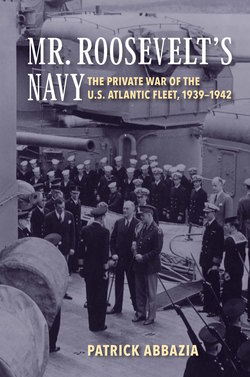Читать книгу Mr. Roosevelt's Navy - Patrick Abazzia - Страница 11
На сайте Литреса книга снята с продажи.
ОглавлениеThe President Defines the Problem
IT WAS ONLY EIGHT DAYS before Christmas, 1937, but none of the men seated at the long table in the Cabinet Room took note of the season. Five days earlier, Japanese aircraft had bombed and sunk the U.S. gunboat Panay in the shallows of the Yangtze River. And now, the Secretary of the Navy, Claude A. Swanson, was telling his colleagues and President Franklin Roosevelt what should be done about this latest crisis in the Far East. Swanson was a stiff, gaunt man; seriously ill, he could not stand up unsupported. White-haired and sallow, he spoke earnestly, a long, full, gray moustache rising and falling with the movement of his lips. He spoke in a thick, gravelly voice which made it difficult for his listeners to understand what he was saying. Sometimes his words gargled together, and only harsh rasps, scratchy and phlegmy, could be heard above the small, restless noises that men make when they are listening to another speak. Secretary Swanson spoke of the need for force; at the least, the U.S. Fleet should be moved from the West Coast to Hawaii.
In a dreamy, distracted way, the crotchety Secretary of the Interior, Harold L. Ickes, evaluated the proposals of his infirm colleague. He sensed in Swanson’s urgency something of the shiny-eyed tenacity of the half-dead man who wants to precipitate grand events to mark his passing. Ickes had absorbed much of the strident, ingenuous pacifism of the liberalism of his generation; indeed, he had once deemed it virtually immoral for the President to allocate WPA funds to the construction of warships. Yet, increasingly, he was coming to believe that he who turns the other cheek gets slapped with the other hand; he feared that only force might restrain the totalitarian regimes. So, almost despite himself, Ickes wondered if the Secretary of the Navy might not be right. If we had to fight, he told himself, perhaps it was a case of better now than later.
Henry Morgenthau, the balding, sad-eyed Secretary of the Treasury, knew that the old man was saying things that needed to be said. Morgenthau had moved through this dismal week with an ache of rage and shame stabbing at him with the remorseless insistence of an abscessed tooth. Outraged by the Japanese attack, he was appalled and then ashamed at the number of people in the government who preferred to ignore the fate of the Panay. To Morgenthau, this was not only bad policy, but also bad morality; a nation had to protect its own. His Department was studying the feasibility of seizing Japanese assets in the United States, and he hoped that the President would announce measures of firmness. Three days ago, Franklin Roosevelt had told him that in the old days the sinking of an American vessel would have automatically been considered an act of war.
But the President had known all week that neither the state of the nation’s arms nor the temper of its people was equal to the task of restraining Japan. The Japanese seemed willing to make reparation for the “incident,” and the President wanted a quick and discreet settlement. Now, the President interrupted Swanson to remark that he wanted to achieve the same ends in the Pacific—but without risking war. He then turned the discussion toward vaguer and safer ground, the possibility of economic sanctions and a “quarantine” of the aggressor states.
But Franklin Roosevelt knew that there were likely to be other such galling episodes, and it profoundly annoyed him that the totalitarian powers were able to achieve diplomatic victories and territorial conquests without formally making war. They achieved their ambitions in a world technically at peace through “civil wars,” “undeclared wars,” and “incidents,” lulling other nations by an avoidance of full-scale, overt war. The President felt that the United States might have to develop a similar technique. And so he told his Cabinet, “If Italy and Japan have evolved a technique of fighting without declaring war, why can’t we develop a similar one?”
Thus, on 17 December 1937, President Franklin Roosevelt defined the problem.1
A few days later, Captain Royal E. Ingersoll, head of the War Plans Division of the Office of Naval Operations, was invited to the White House. Ingersoll was a “rumpled,” scholarly officer with a bent for staff work and a distaste for publicity. The President ordered him to Britain to discuss the possibility of Anglo-American naval cooperation, but he was to make “no commitments” on behalf of the United States. Ingersoll understood. As he explained, “We had to make preliminary arrangements to explore what could be done—for communicating with each other, for establishing liaison, intelligence, and other things, so if war did come we would not be floundering around for months until we got together.”2
The President had taken his first step toward a policy of “fighting without declaring war.” It was merely a small, tentative step, but in due time, his pace would quicken, and ships yet unbuilt would steam away on business in great waters.
